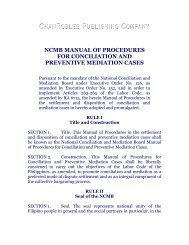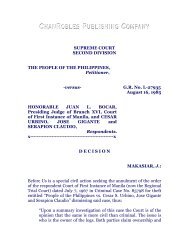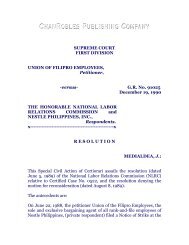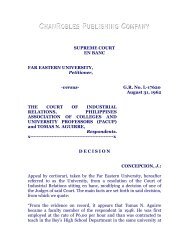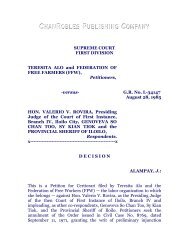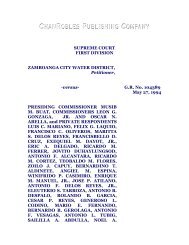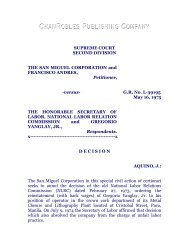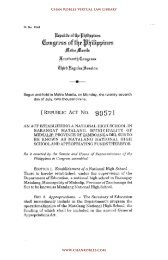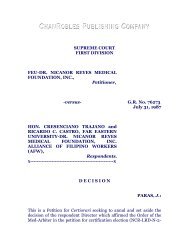part 2 - Chan Robles and Associates Law Firm
part 2 - Chan Robles and Associates Law Firm
part 2 - Chan Robles and Associates Law Firm
You also want an ePaper? Increase the reach of your titles
YUMPU automatically turns print PDFs into web optimized ePapers that Google loves.
Pre-Week Guide on Labor <strong>Law</strong> 2006 Bar Examinations Prof. Joselito Guianan <strong>Chan</strong>the position taken by the company that each sales office consists of one bargaining unit. Said theCourt: “What greatly militates against this position (of the company) is the meager number ofsales personnel in each of the Magnolia sales office in Northern Luzon. Even the bargaining unitsought to be represented by respondent union in the entire North Luzon sales area consists only ofapproximately fifty-five (55) employees. Surely, it would not be for the best interests of theseemployees if they would further be fractionalized. The adage ‘there is strength in number’ is thevery rationale underlying the formation of a labor union.”In another case involving the same company, San Miguel Corporation Supervisors <strong>and</strong>Exempt Employees Union vs. Laguesma, [G. R. No. 110399, August 15, 1997, 277 SCRA 370,380-381], the fact that the three plants comprising the bargaining unit are located in threedifferent places, namely, in Cabuyao, Laguna, in Otis, P<strong>and</strong>acan, Metro Manila, <strong>and</strong> in SanFern<strong>and</strong>o, Pampanga was declared immaterial. Geographical location can be completelydisregarded if the communal or mutual interests of the employees are not sacrificed asdemonstrated in University of the Philippines vs. Ferrer-Calleja, [211 SCRA 451 (1992)],where all non-academic rank-<strong>and</strong>-file employees of the University of the Philippines in Diliman,Quezon City, Padre Faura, Manila, Los Banos, Laguna <strong>and</strong> the Visayas were allowed to<strong>part</strong>icipate in a certification election. The distance among the three plants is not productive ofinsurmountable difficulties in the administration of union affairs. Neither are there regionaldifferences that are likely to impede the operations of a single bargaining representative.In Alhambra Cigar <strong>and</strong> Cigarette Manufacturing Co., vs. Alhambra EmployeesAssociation-PAFLU, [G. R. No. L-13573, Feb. 20, 1969], employees in the administrative, sales<strong>and</strong> dispensary de<strong>part</strong>ments perform work which have nothing to do with production <strong>and</strong>maintenance, hence, it was held that they can form their own bargaining unit separate <strong>and</strong> distinctfrom those involved in the production <strong>and</strong> maintenance such as those employed in the raw leaf,cigar, cigarette, packing, engineering <strong>and</strong> maintenance de<strong>part</strong>ments.But in the case of employees of two (2) companies, a different legal principle applies.Although the businesses of two companies are related <strong>and</strong> the employees of one were originallythe employees of the other, the employees of both companies cannot be treated as one bargainingunit because they are employed by two separate <strong>and</strong> distinct entities. (Diatagon LaborFederation Local 110 of the ULGWP vs. Ople, G. R. Nos. L-44493-94, Dec. 3, 1980, 101 SCRA534; Indophil Textile Mill Workers Union-PTGWO vs. Calica, G. R. No. 96490, Feb. 3, 1992).In a case involving a film outfit, LVN Pictures, Inc. vs. Philippine Musicians Guild, [1SCRA 132 (1961)], it was pronounced following the substantial mutual interests test, that there issubstantial difference between the work performed by musicians <strong>and</strong> that of other persons who<strong>part</strong>icipate in the production of a film which suffices to show that they constitute a properbargaining unit.In Cruzvale, Inc. vs. Laguesma, [G. R. No. 107610, Nov. 25, 1994], it was ruled thatthere is no commonality of interest between the employees in the garment factory <strong>and</strong> cinemabusiness. Thus, their separation into two (2) distinct bargaining units was declared proper.Also, in Golden Farms, Inc. vs. The Honorable Secretary of Labor, [G. R. No.102130, July 26, 1994], the dissimilarity of interests between monthly-paid <strong>and</strong> daily-paidworkers - where the former primarily perform administrative or clerical work; while the lattermainly work in the cultivation of bananas in the field – was held proper basis for the formation ofa separate <strong>and</strong> distinct bargaining unit for the monthly-paid rank-<strong>and</strong>-file employees.The Globe doctrine [will of the employees] is was enunciated in the United States case ofGlobe Machine <strong>and</strong> Stamping Co., [3 NLRB 294 (1937)] where it was ruled, in defining theappropriate bargaining unit, that in a case where the company’s production workers can beconsidered either as a single bargaining unit appropriate for purposes of collective bargaining or,as three (3) separate <strong>and</strong> distinct bargaining units, the determining factor is the desire of theworkers themselves. Consequently, a certification election should be held separately to choosewhich representative union will be chosen by the workers. (See also Mechanical De<strong>part</strong>mentLabor Union sa Philippine National Railways vs. CIR, G. R. No. L-28223, Aug. 30, 1968).In the case of International School Alliance of Educators [ISAE] vs. Quisumbing, [G.R. No. 128845, June 1, 2000], the Supreme Court ruled that foreign-hired teachers do not belong40


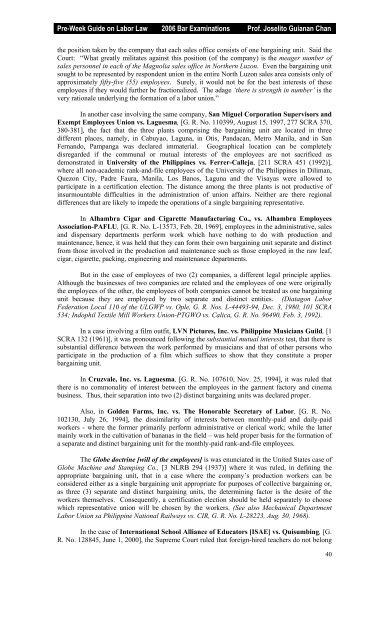
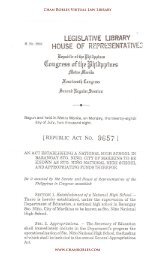
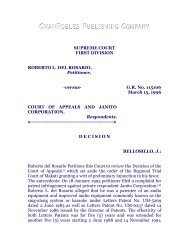
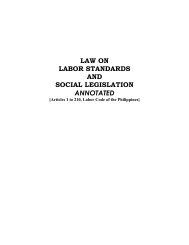
![Aurelio vs. NLRC, (221 SCRA 432 [1993]) - Chan Robles and ...](https://img.yumpu.com/51280528/1/190x245/aurelio-vs-nlrc-221-scra-432-1993-chan-robles-and-.jpg?quality=85)
